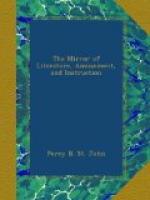Life of Wren.—Family Library.
[4] The original inscription,
ascribing to the Roman Catholics the
fire
which consumed the city, obliterated during the reign
of
James
II. and restored with much pomp on the coming of King
William,
is now ordered, I hear, to be erased by the Common
Council.
Fiction is truth and truth is fiction as party prevails.
* * * * *
G. MORLAND.
H. Morland, wine merchant, brother of the painter, says, “that his brother died while his servant was holding a glass of gin (his favourite liquor) over his shoulder. And he was so prodigal at times that he had not enough to buy ultra-marine with, although a few hours before he had invited a great number of his associates to a general debauch.”
GEO. ST. CLAIR.
* * * * *
[Illustration: COWLEY’S HOUSE, AT CHERTSEY.]
COWLEY’S HOUSE, AT CHERTSEY.
Cowley retired to these premises at Chertsey, in Surrey, a few years before his death, which took place here in 1667, in his 49th year. The premises are called the Porch House, and were for many years occupied by the late Richard Clark, Esq., Chamberlain of London, who died a short time since. Mr. Clark, in honour of the Poet, took much pains to preserve the premises in their original state, kept an original portrait of Cowley, and had affixed a tablet in front, containing Cowley’s Latin Epitaph on himself. In the year 1793, it was supposed that the ruinous state of the house rendered it impossible to support the building, but it was found practicable to preserve the greater part of it, to which some rooms have been added. Mr. Clark also placed a tablet in front of the building where the porch stood, with the following inscription:—“The Porch of this House, which projected ten feet into the highway, was, in the year 1792, removed for the safety and accommodation of the public.
“Here the last accents flowed from Cowley’s tongue.”
We received the substance of this information from the venerable Mr. Clark himself, in the year 1822, about which time there appeared, in the Monthly Magazine, a view of the original premises, from a drawing by the late Mr. Samuel Ireland. The above view was taken by a Correspondent, in the summer of 1828, and represents the original portion of the mansion. Cowley’s study is here pointed out, being a closet in the back part of the house, towards the garden.




